2023.08.04.69
Files > Volume 8 > Vol 8 no 4 2023
Effect of Some Chemical Herbicides on the Weeds Accompanying the Field's Peanut Crop
B.A.A. Al-Yasari 1,
M.N.H. Al-Yasari 2*
1 University of Kerbala/ College of
Agriculture/ Kerbala, Iraq; [email protected].
2 University of Kerbala/ College of
Agriculture/ Kerbala, Iraq;
*Corresponded
author[email protected].
Available from.
http://dx.doi.org/10.21931/RB/2023.08.04.69
ABSTRACT
A field experiment was
conducted during the spring season of 2021 in a selected field of preparative
Ibn Al-Bitar occupational/ Al-Hussainiya region in Holy Karbala. The experiment
involved cultivating peanut plants (Arachis hypogaea L.), specifically a
local variety, in soil characterized by a clay loam texture. The experiment
aimed to determine the most effective chemical herbicides for controlling weed
growth in conjunction with the Peanut crop. The experiment utilized a
randomized complete block design (RCBD) with three replications. The study encompassed six conditions: weedy and weed-free, which
were under manual control for the entire duration of the growing season.
Furthermore, there were treatments that involved the administration of chemical
herbicides before planting, specifically Trifluralin and Pendimethalin, which
were applied ten days before the planting phase.
Additionally,
post-planting herbicides, namely Oxyfluorfen and Clethodim, were sprayed during
the vegetative growth phase of the plant as well as at the initiation of the
flowering stage. The herbicides were administered according to the prescribed
dosages. The findings demonstrated significant differences in the management
procedure utilizing chemical herbicides throughout a 30-day period of applying
said herbicides. This discrepancy became apparent when evaluating the two
herbicides, specifically Oxyfluorfen and Pendimethalin, which produced the
lowest quantity of broad-leaf weeds, with a recorded density of 4.6 and 7.6
plants m-2, respectively.
Additionally, the results
demonstrated that notable disparities were observed after 60 days from the
application of herbicides. Specifically, the herbicides Pendimethalin and
Oxyfluorfen exhibited the lowest density of broad-leaf weeds, with a count of
4.6 and 6.0 m-2 plants, respectively. Moreover, the impact of
herbicides on narrow-leaf weed was examined at 30 and 60 days post-spraying.
There was no significant difference in the means of the herbicides, and the
herbicides Oxyfluorfen and Pendimethalin yielded the least density of broad
leaf weeds after 90 days of herbicide application, with quantities of 6.0 and
6.3 plant m-2, respectively. Similarly, concerning narrow-leaf weed density on
the same date, the herbicides Trifluralin, Clethodim,, and Ox-yfluorfen
exhibited superiority in achieving the lowest density of narrow-leaf weeds,
with quantities of 5.0, 5.3, and 5.6 plant m-2, respectively.
Furthermore, no statistically
significant difference was observed among these herbicides. The findings
demonstrate the superiority of the herbicides Oxyfluorfen and Pendimethalin in
achieving the highest percentage of control for broad-leaf weeds after 30, 60,
and 90 days of herbicide application. Regarding the specific dates for the
narrow-leaf weeds, the herbicides Oxyfluorfen, Clethodim, and Trifluralin
exhibited superiority in providing optimal control. In
contrast to alternative treatments involving herbicides, the herbicide
Oxyfluorfen showcased the most diminished mean mass and the utmost level of
hindrance on both extensive and limited-leafed weeds.
Keywords: Herbicides; Oxyfluorfen; Pendimethalin; Clethodim;
Trifluralin; Weeds; Narrow leaf; Broad leaf.
INTRODUCTION
Peanut (Arachis hypogaea L.) of substantial economic value in the
world, returns to the Leguminosae, which is of high nutritional value, as its
seeds contain (45-50)% oil, (27-33)% protein and a primary source of minerals
and vitamins1, Iraq consumes large quantities of this crop, more
than 40 thousand tons annually, to be used in oil extraction, It is hoped that
the cultivated area in Iraq of this crop will increase due to the increased
demand for it for its multiple industrial benefits2, which is
limited compared to the countries producing this crop, The production of the
field Peanut annually is about 41.9 million tons and contributes 7.3 % of the
total oil seed production in the world for the year 20183. Iraq
consumes large quantities of this crop, more than 40 thousand tons annually,
for oil extraction. It is hoped that the cultivated area of this crop in Iraq
will increase due to the increased demand for its multiple industrial benefits4.
There are many weeds in the field of Peanut in Iraq, Nutgrass (Cyperus rotundus L.), Barley
grass (Imperata cylindrical L.), Wild oats (Avena fatua
L.), Rough pigweed (Amaranthus retroflexus L.), Button weed (Malva
rotundifolia L.), Smeller Bind Weed (Convolvulus arvensis
L.), Purslane (Portulaca oleracea L.)5, Weeds
herbicides are considered as an alternative or supplement
to combat harmful weeds through manual hoeing, and they are the latest research
findings of effective means of tackling these plants, and if these compounds
are better used, they give guaranteed results, It is considered one of the most
effective means of combating weeds of various types , especially pre-planting
herbicides such as Trifluralin, which is a selective,
specialized herbicides used to control
weeds seeds in soybean, bean and pea fields in the (3-4) leaf stage to control
seasonal weeds and broad leaves weeds,
it prevents root growth by interrupting cell division6, As well as
Pendimethalin, which has the same effect as Trifluralin, but it is used before
or after planting to control narrow leaves weeds and some broad leaves weeds in
cotton, corn and soybean fields. These herbicides belong to the Dinitroaniline
group7. Oxyfluorfen belongs
to the Diphenylether group. It is a selective herbicide that inhibits the
synthesis of chlorophyll and carotene. It is used by contact or spraying
directed at the weeds and not directed at the plant to avoid the effect of the
herbicides as much as possible in large areas of uncontrolled lands8.
Untargeted spraying did not cause any toxicity symptoms on the plant, as it is
used before or after germination to control annual weeds in cotton and soybean
fields 9. Clethodim is also used after germination to control
narrow-leaf weeds in grass and dicotyledons and inhibits the synthesis of fatty
acids. In chloroplasts, the herbicides belong to the cyclohexanedione group10. Given the importance
of the study on weed control and increasing production of peanut plants, this study came to evaluate the efficiency of Trifluralin,
Pendimethalin, Oxyfluorfen and Clethodim in controlling the different types of
weeds associated with field peanut crops.
MATERIALS AND METHODS
A field experiment was conducted in a
field located in the preparative Ibn Al-Bitar occupational / Al-Hussainiya
region in Holy Karbala for the spring season of 2021. The experiment involved cultivating
the Peanut plant (Arachis hypogaea L.), a local variety, in soil with a
clay loam texture. The experiment followed a randomized complete block design
(RCBD) with three replications. The field's
soil was prepared for cultivation through plowing, smoothing and leveling. It
was divided into three replicates, the distance between each two replicates (1.5)
m. Each replicate contains 18 experimental units, with an area of 3 x 3 m2;
one experimental unit represents an area of 9 m2, the unit includes
three lanes, and the seeds of field peanuts of the local variety, were planted
in the spring season on 12/4/2021 on lines, as the distance between line. Another
was 75cm, and between one seed and another was (30)cm,the planting was done on
one side of the line and by three lines to obtain a plant density of (44440)
plants ha-1, and 2-3 seeds were placed in each hole at a
depth of 5-3 cm11,The thinning process was carried out after the
plant reached a height of 20-25cm and the incubation process was carried out,
i.e. collecting the soil around the plant so that the spurs emerging in the
period after flowering time could penetrate the soil and ensure the
preservation of soil moisture and increase the yield12. The experimental
design comprised of six different treatments, namely weedy and weed-free. These
treatments were meticulously controlled by manual intervention throughout the
entire growth season.
Additionally, there were treatments involving the application of
chemical herbicides, Trifluralin 48% EC and Pendimethalin 33% EC, which were
sprayed onto the crops ten days before planting. Furthermore, after planting
herbicides, Oxyfluorfen 24% EC and Clethodim 120 gL-1, were also sprayed during
the vegetative growth and initial flowering stages. It is worth noting that all
sprayed herbicides were used at the recommended rates and were registered following
the guidelines set by the Ministry of Agriculture in Iraq13.
A 16-liter dorsal sprayer was used and a diffuser such as bubblegum
was added in an amount of 0.16 ml L-1 to break the superficial
tension layer of the plant leaves because there is a waxy layer covering the
stomata. Mineral fertilizers were added to the experiment according to the
fertilizer recommendation: 100 Kg N ha-1, 80 Kg P ha-1
and 150 Kg K ha-1, as urea fertilizer (46% N), mono superphosphate
fertilizer (P2O5 20%) and potassium sulfate fertilizer
(50% K2O) were added. Respectively, as sources of nitrogen,
phosphorous and potassium to the soil by feeding method at a depth of 5 cm14, the characteristics studied were:
· Types and density of the Weeds
(plant m-2).
The types of weeds
were diagnosed, and their density was calculated on the dates (30, 60, and 90)
of planting by analyzing and calculating the number of weeds in a square meter
of the experimental unit. Table 2. shows the types of weeds, narrow and broad leaves,
in the practical field.
· Weeds control percentage (%).
It was calculated after
(30, 60 and 90) days after Farming 15. According to the following
equation
% control = (Weed density in the control treatment - Weed
density in the control treatment \ Weed density in the control treatment) x 100
· Weed dry weight (gm m-2).
The weed was cut at
ground level, placed in perforated bags, and then in the oven at 60 degrees
Celsius until the weight was stable 16.
· The percentage of inhibition in
the dry weight of the weed.
The percentage of
inhibition was calculated in the dry weight of the weeds for different
treatments 15.
According to the
following equation
%Inhibition = (100 - A
\ B) 100, whereas:
A = dry weight of the
weeds in the weeds control treatments
B = dry weight of the
weeds in the weed's treatment
The data were statistically analyzed, and the
arithmetic means were compared according to the least significant difference
test (LSD) at the probability level (0.05).
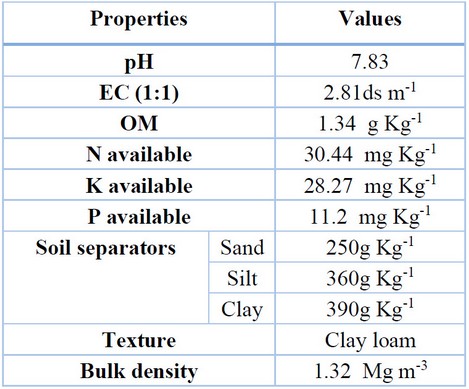
Table 1.
Chemical and physical properties of the study soil at a depth of (0-30) cm
before oat planting.

Table 2.
Contains the scientific names of the herbicides, the active substances, and the
concentrations used.
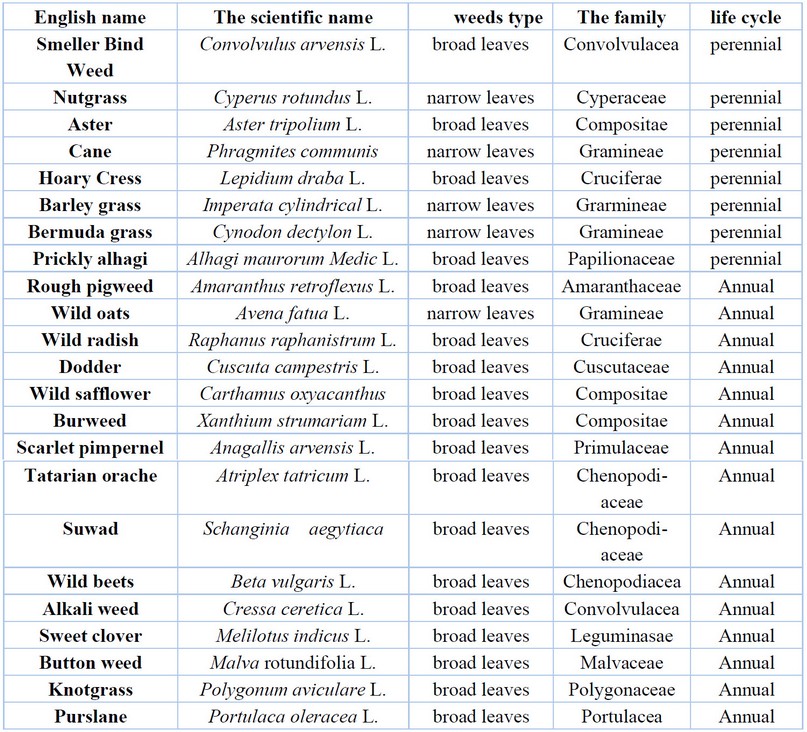
Table 3. Types of broad and narrow leaf
weeds in the experimental field.
RESULTS
Effect of weed control on weed density (plant m-2)
associated with field peanut crop.
The field peanut crop accompanies many
species of annual, transforming, and perennial weeds due to the long growth
period and the suitability of its environmental conditions to the winter and
summer weeds. Types of weeds in comparative treatments Weedy in which the weeds
were left to compete with the crop throughout the growing season. The results
indicated in Table 4 that weed control significantly affected the total
densities of broad and narrow leaf weeds for the (30) day of spraying the
herbicides. The treatment with the herbicide used after planting Oxyfluorfen
gave the lowest density of the total weed amounted to (7.9) plants m-2,
which was significantly superior in reducing the densities of the weed compared
to the weedy treatment, which amounted to (34.2) plant m-2-as well
as the herbicide treatments that did not have a significant difference between
them Trifluralin, Pendimethalin and
Clethodim, which amounted to 14.9, 15.6 and 13.3 plant m-2 respectively.
The results also showed significant differences in the chemical herbicide control process for the same date concerning
broad leaf weed compared to the weedy treatment, which amounted to (25.5)
plants m-2 for all herbicides used before and after planting. m-2
was followed by the herbicide Pendimethalin, which reached (7.6) plants m-2,
which did not have a significant difference between them.
In contrast, Trifluralin and Clethodim herbicides demonstrated a
notable disparity in their impact, as evidenced by the higher density of weeds
observed, precisely 10.3 and 10.0 plants m-2, respectively. Conversely, when examining the narrow-leaf weeds
for the same period, there was no discernible distinction between the mean
values of the herbicides. The herbicides Oxyfluorfen and Clethodim produced the
least weed density, with 3.3 and 3.3 plants m-2, respectively.
The results showed in the same table that for
the 60 days of spraying the herbicides, weed control significantly affected the
total density of broad and narrow leaf weeds. Significantly in reducing the
weed densities compared to the weedy treatment, which amounted to 34.2 plants m-2
and did not differ significantly from the herbicide treatments Trifluralin,
Pendimethalin and Clethodim, which amounted to 14.3, 13.2 and 16.0 plants m-2
respectively, the results also showed that there were significant differences
in the chemical herbicide control process for the same date concerning broad
leaf weed compared to the weedy treatment, which amounted to 25.5 plants m-2
for all herbicides used before and after planting, where the herbicide
Pendimethalin, gave the lowest density of broad weed amounted to 4.6 plants m-2
was followed by the herbicide Oxyfluorfen, which reached 6.0 plants m-2,
The results showed in the same table for the 90 day date of spraying the
herbicides that there was a significant effect of weed control in the total
densities of broad and narrow leaf weeds. The weed densities were reduced
compared to the weedy treatment, which amounted to 34.2 plants m-2
and the Clethodim treatment, which amounted to 18.9 plants m-2.
However, it did not differ significantly from the treatment of the herbicides
Trifluralin and Pendimethalin, which amounted to 15.6 and 17.3 plants m-2
on the results also showed significant differences in the control process with
chemical herbicides for broad leaf weeds for the same date compared to the
weedy treatment, which amounted to 25.5 plants m-2. It reached (6.3)
plants m-2, which had no significant difference, while the two agents responsible for the eradication of pests,
Trifluralin and Clethodim, exhibited a greater concentration of plants per
square meter for broad leaf weeds, specifically 10.6 and 13.6 plants,
respectively. In regards to narrow leaf weeds during the same time frame, all
of the herbicides, including Trifluralin Pendimethalin, Clethodim, and
Oxyfluorfen, demonstrated a higher level of efficacy in reducing the number of
narrow leaf weeds to the lowest possible density, specifically 5.0, 11.0, 5.3,
and 5.6 plants m-2, respectively compared to the weedy treatment which gave, (8.7)
plants m-2, and none of these herbicides moral difference.
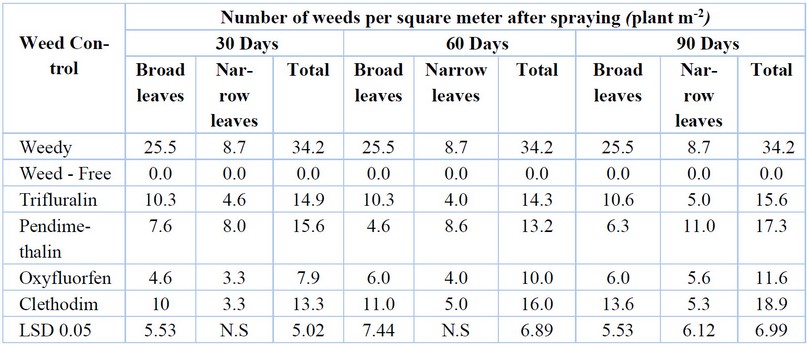
Table 4. Effect of Weed Control on weed densities
m-2 during crop growth stages
(30,60 and 90) days of weed control.
Weeds control percentage (%)
The percentage of weed control depends on the density of weed
plants in the weed treatment and the thickness of the weed in the other
treatments. The results indicated in Table 5. that the herbicide Oxyfluorfen
achieved the highest control percentage of the total densities of broad and
narrow leaf weeds, which amounted to (70.1) %. It did not differ significantly
from the average herbicides, Trifluralin, Pendimethalin and Clethodim, which
amounted to (54, 51.5 and 61.1) % for the (30) day date of spraying the
herbicides. The results also showed significant differences in the percentage
of weed control for the same date concerning broad-leaf weed. All the
herbicides used before and after planting were significantly superior to the
weedy treatment, which amounted to (0.0) %, and Oxyfluorfen gave the highest
percentage. The percentage of broad leaf weed control was (78.6%), followed by
the herbicide Pendimethalin, which reached (69.8%) and there was no significant
difference between them.
In contrast, the two herbicides, Clethodim and Trifluralin, gave the lowest Weed control
percentage on broad-leaf weed (60.7 and 59.4). As for the narrow leaf weeds
of the same date, the two herbicides, Oxyfluorfen and Clethodim, outperformed
in giving the highest Weed control percentage for the narrow leaf weed,
which amounted to (61.6 and 61.6) percent, respectively, followed by the
herbicide Trifluralin, which gave (48.6%) and did not There was a significant
difference between these herbicides in the percentage of control for narrow
leaf weeds. In contrast, the herbicide Pendimethalin recorded the lowest
control rate of 33.3% compared to other herbicides. The results showed in Table
5. that the herbicide Oxyfluorfen achieved the highest Weed control
percentage for the total broad and narrow leaf weeds, which amounted to (65.2)
%, and did not differ significantly from the herbicides Trifluralin and
Clethodim, which amounted to (56.7 and 49.6) %, respectively, for the 60 days
of spraying the herbicides. The results also showed significant differences in
the percentage of broad-leaf weed control for the same date. All the herbicides
used before and after planting were significantly superior to the weedy
treatment, which amounted to (0.0) %, and the two herbicides, Pendimethalin and
Oxyfluorfen, were higher. The percentage of controlling broad-leaf weed reached
(81.6 and 76.4%) respectively, and there was no difference between them. At the
same time, the two exterminators, Trifluralin and Clethodim, were given (59.4
and 56.8%) respectively. As for the broad-leaf weed for the same date,
Trifluralin, Oxyfluorfen and Clethodim were outperformed. In giving the highest
percentage of control for narrow leaf weed, it reached (54, 54 and 42.5%)
respectively, and there was no significant difference between these herbicides
in the percentage of control for narrow leaf weed. As for Pendimethalin, it was
recorded. The lowest control rate was (10.3%) compared to other herbicides. The
herbicides Trifluralin, Oxyfluorfen and Clethodim significantly increased the
percentage of control on thin weed compared with the weedy treatment. The
results showed in the same table for the date of (90) days of spraying the
herbicides that all the herbicides, Oxyfluorfen, Pendimethalin, Trifluralin and
Clethodim, achieved a significant increase in the Weeds control percentage of
the total number of broad and narrow leaf weeds amounted to (55.6, 52.6, 49.7
and 42.4) %, respectively, compared to the weedy treatment, which amounted to (0.0)
%. The results exhibited noteworthy disparities in the proportion of effective
suppression of broad-leaf weeds on a given day. Both Oxyfluorfen and
Pendimethalin, the two herbicides, appreciably escalated the degree of
suppression for broad-leaf weeds, resulting in approximately 76.4% and 75.1%,
respectively. There was no significant difference between them, while the two
herbicides, Trifluralin and Clethodim, gave the lowest control percentage on
broad leaf weed (56.7 and 46.3%), respectively, compared to other herbicides,
as for the narrow leaf weed for the same date, all herbicides outperformed
compared to the weedy treatment in giving the highest Weeds control percentage
for the narrow leaf weed (42.5, 30.2, 34.8 and 38.6)% for the herbicides
Trifluralin, Pendimethalin, Oxyfluorfen and Clethodim respectively.
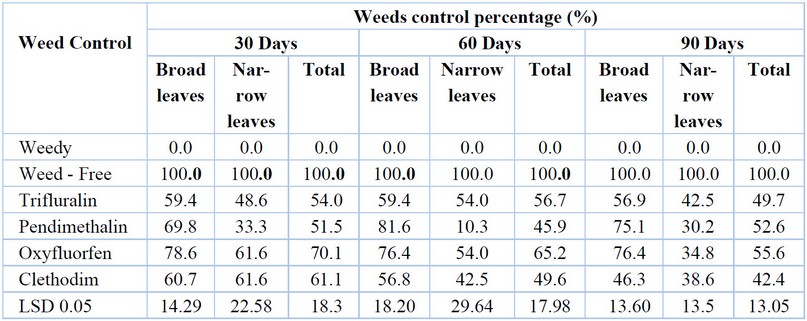
Table 5. The effect of weed control on the percentage of weed
control (m2) during the crop growth stages for the planting season.
Dry weight of the weeds (gm m-2)
The
study of the dry weight of broad, narrow leaves and total weeds is one of the
essential matters, which is added to the density and percentage of weed control
to know the efficiency of the herbicides used before and after planting. The
results in Table 6 indicated the superiority of the herbicide Oxyfluorfen,
which significantly reduced the dry weight of the total number of broad and
narrow weeds. The leaves amounted to (142.90) gm m-2 compared to the
weedy treatment as well as the herbicide treatments Trifluralin, Pendimethalin
and Clethodim, which amounted to (1043.3, 264.90, 385.60 and 242.70) gm m-2,
respectively. Also, with the herbicide Oxyfluorfen, the average dry weight of
broad leaf weeds reached (82.30) g m m-2, which was significantly
superior to that of the weedy treatment and the herbicide treatments
Trifluralin, Pendimethalin and Clethodim (which recorded (547.5, 264.90, 385.60
and 242.70) gm. m-2 respectively, and the herbicide Oxyfluorfen was significantly
superior in recording the lowest average dry weight of narrow leaf weeds
amounting to (60.60) gm m-2, It was significantly superior compared
to the weedy treatment and Trifluralin, Pendimethalin and Clethodim treatments
which recorded (495.8, 88.50, 229.90 and 93.10) gm m-2,
respectively.
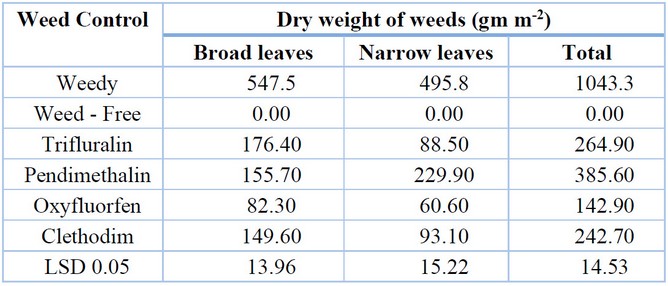
Table 6. The effect of herbicide on the dry weight
of the weeds (gm m-2).
Percentage of Inhibition in the dry weight of the Weeds
The
study of the percentage of weed inhibition is one of the essential things that
is added to the dry weight of broad and narrow-leaf weeds. The results
indicated in Table 6. that Oxyfluorfen gave the highest percentage of
inhibition in the total dry weight of wide and narrow leaf weeds, which
amounted to (86.1%) and thus exceeded Significantly compared to the treatments
of the herbicides Trifluralin, Pendimethalin and Clethodim, which amounted to
(54.0, 51.5 and 61.1)%, respectively. The findings also demonstrated
noteworthy dissimilarities in broad-leaf weeds' dry weight inhibition
percentage. Oxyfluorfen exhibited superiority by yielding the highest
inhibition percentage in the dry weight of broad-leaf weeds, which equated to
88.8%. This superiority was significantly higher than the treatments involving
the two herbicides, Pendimethalin and Trifluralin, which amounted to 80.9% and
77.9%, respectively. These values did not differ significantly from the
Clethodim treatment, which amounted to 81.5%.
Regarding narrow-leaf weeds, Oxyfluorfen
surpassed others by providing the highest inhibition percentage in the dry
weight of the narrow-leaf weeds, which amounted to 83.4%. This exceeded the
herbicide treatments using Pendimethalin and Clethodim, which amounted to 37.5%
and 73.8%, respectively. However, it did not differ significantly from the
treatment involving Trifluralin, which amounted to 75.5%. The results indicated
that all the herbicides employed significantly increased the inhibition rate
for broad and narrow weeds compared to the Weedy treatment.
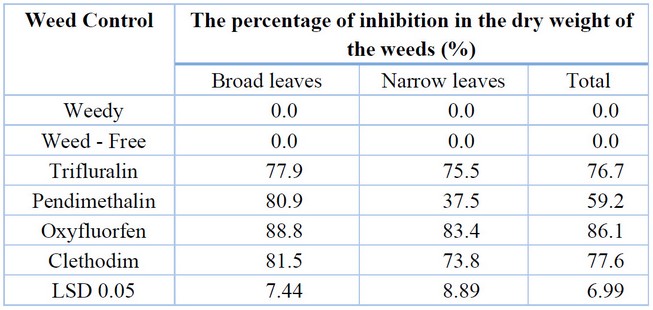
Table 7. The effect of herbicide on the percentage of
inhibition in the dry weight of the weeds.
DISCUSSION
The decrease in the density of broad and narrow-leaf weeds is due
to the herbicides used in Table 4. Oxyfluorfen used after planting has a
non-selective character that works by contact and eliminates all types of
annual weeds and perennial broad and narrow leaf weeds 17,18, while
the herbicides used is Clethodim. After planting, it is selective; it
eliminates annual and perennial weeds with narrow leaves only10, so
the types of weeds plants affected by spraying when using Oxyfluorfen
herbicides were greater than when using Clethodim, While the herbicides
Pendimethalin used before planting is an elective herbicide that eliminates
annual and perennial narrow and broad leaves weeds7,19. Trifluralin,
used before planting, is also an elective herbicide that eliminates weeds, such
as weed seeds, during germination. Narrow and broad annual leaves are only
6,20, so the types of weeds plants affected by spraying when using
Pendimethalin were greater than when using Trifluralin. It is noted from the
results in Table 5. The superiority of herbicides after planting Oxyfluorfen in
achieving the highest rate of control of broad and narrow weeds for the dates
of (30, 60 and 90) days of spraying, due to its effect on all types of weeds,
followed by herbicides after cultivation, Clethodim, which excelled in giving
the highest rate of combating narrow-leafed weeds only. Before planting
Trifluralin and Pendimethalin, each of them achieved a varying increase in the
rate of controlling broad, narrow, annual and perennial weeds for all dates,
and this is due to the specificity of the effect of all herbicides on different
types of weeds, especially in annual and perennial weeds for broad and
narrow-leaved weeds, and this means that the exterminator after Agriculture
Oxyfluorfen was more efficient in controlling most of the weeds in the
experimental field21. In contrast, the post-cultivation herbicide
Clethodim decreased its efficiency in combating the narrow-leaved weeds of
annuals and perennials22.and the percentage of a discrepancy between
the two herbicides is because the herbicides Trifluralin before planting is
related to its efficiency through its effect on the seeds of the annual weeds
only, which are broad and narrow-leaved. Agriculture Pendimethalin is found in
the upper parts of the soil surface, so weed seeds are not affected by the
herbicide and can germinate below the area where the herbicide is located23.The
herbicide showed a different effect between broad and narrow-leaved weeds and
annual and perennial weeds, as in Table 6. This may be due to the
post-cultivation herbicide Oxyfluorfen, which showed a clear superiority in
reducing the dry weight of the weeds due to its control of all types of broad
and narrow-leaved weeds, annuals and perennials without exception24.
While Trifluralin before planting showed a decrease and decrease in the dry
weight of the weeds as a result of controlling the broad annual weeds and the narrow
leaf weed annual without growing again and without affecting the perennial
weeds25.and a herbicide works after planting Clethodim, which showed
a clear superiority in eliminating the narrow leaved annual weeds, which gave
way to the broad leaved annual and perennial weeds to grow in the experimental
land and a clear increase in the dry weight of different weeds except for the
narrow weeds26, while an exterminator was given before planting
Pendimethalin increases the dry weight
of annual weeds, broad leaved and perennial weeds, due to the fact that the
herbicide is on the surface layer of the soil without affecting the seeds of
the weeds growing under the surface of the soil and below the area where the
herbicide is located, which leads to seed germination and an increase in the
number of weeds and thus an increase in weight Dry broad leaved weeds9.
Increasing the dry weight of broad and narrow-leaved weeds is one of the
important matters on which these weeds depend in competition for growth
requirements. After planting, Oxyfluorfen works to reduce the efficiency of the
photosynthesis process and chlorophyll and carotene dye, causing a defect in
the installation of membranes and the disappearance of green color and
whiteness of the leaf and the elimination of the number of a large number of
weeds leads to a decrease in their dry weight27.After planting,
Clethodim inhibited the weight of the dry weeds, which is represented in its
effect on the biosynthesis of fatty acids in the chloroplasts and the inhibition
of cell formation in cellular tissues, which leads to abnormal growth and
weakens its ability to compete for the basic requirements for growth28.The
pre-planting herbicides Trifluralin and Pendimethalin prevent and inhibit the
cell division of the growing tops and the vegetative and root systems. The lack
of movement of materials represents the photosynthesis process from the source,
which is the root of the estuary. Thus, the growth is abnormal, the competition
is low, and the dry weight of the weeds is reduced29,30.
CONCLUSIONS
The importance of controlling with the
herbicides used in the experiment, especially spraying with Oxyfluorfen after planting and at the
beginning of the flowering phase of the peanut plant to obtain control operations
free of annual and perennial weeds of different types without affecting the
yield and its components and other characteristics as well as the effect of
this herbicide on Reduce weeds densities after planting.
Author Contributions: Badr.A. and MN; methodology, MN; software, Badr.A.; validation, MN
and Badr.A.; formal analysis, MN; investigation, Badr.A.; resources, MN; data
curation, Badr.a.; writing original draft preparation, MN; writing-review and
editing, Badr.A.; supervision, MN; visualization, MN; project administration,
BadrA.; funding acquisition, Badr. A. All authors have read and agreed to the
published version of the manuscript.
Funding: This research received no external funding.
Acknowledgments: The authors thank the
Department of Field Crops, College of Agriculture, University of Kerbala, Iraq,
for providing the Peanut seeds and laboratory materials.
Conflicts of Interest: The authors declare no
conflict of interest, and the funders had no role in the study's design, , in
the writing of the manuscript, in the collection, analyses, or interpretation
of data or in the decision to publish these results.
REFERENCES
1. M El- Naim, A.k.;
Eldouma, M.A.; Ibrahim, E.A.; Zaled, M. B. Z. Influence of Plant Spacing and
Weeds on Growth and Yield of Peanut (Arachis hypogaea L.) in
Rain-fed of Sudan. Adv. in life Sci,2011, 1.2: 45-48.
2. Al-Kaisy E.H.;Al-Saad,A.A.An economic analysis
for some factors affecting peanuts productivity in Diyala province. Iraqi
J.Agric. Sci.2010, 41.4: 65-73.
3. Ali, H.H., AL-Rawi,
K., Khalaf, Y., Alaaraji, S., Aldahham, B., Awad, M., Al-ani, O., Al-ani, F.,
Ali, A.T. Serum Caveolin-1 Level is Inversely Associated with Serum Vaspin,
Visfatin, and HbA1c in Newly Diagnosed Men with Type-2 Diabetes (2022) Reports
of Biochemistry and Molecular Biology, 11 (2), pp. 299-309.
4. Al-Younis, A.A.;
Al-Karkji,A.S. Cultivation of oil crops in Iraq and its development. A chapter
from the book Cultivation of Industrial Crops in Iraq,2017.
5. Soltani,
N.;Shropshire,C.;P.H.Sikkema.;P.H.Tolerance of mung bean to postemergence
herbicides. Agric. Sci,2013, 04.10: 558-562.
6. Qasem,J.R.Herbicides
applications: problems and considerations. In: Kortekamp A (ed) Herbicides and
environment. InTech, Rijeka,2011, pp 643–664.
7. A. Zaili, S., M.
Alabdaly, M. Responce Of Growth And Yield Of Local Garlic Allium Sativum To
Potassium Fertilization And Planting Date. Anbar Journal Of Agricultural
Sciences, 2023; 21(1): 54-63. doi: 10.32649/ajas.2023.179715.
8.
Alshugeairy ZK, Alogaidi FF, Hadi BH, Hassan WA. Path
coefficient analyses of introduced rice varieties under different planting
distances. SABRAO J. Breed. Genet. 2023,1;55(2):516-24.
9. Abudulai,M.;
Jesse,N.;Shaibu, S.S.;Israel, D.;Kenneth, B.; Rick ,B. Peanut (Arachis hypogaea L.) response
to weed and disease management in northern Ghana. Int. J. of pest Manag,2018,
1366-5863.
10. Al-Zamiti, M.S. Herbicides
Plant Protection Department - Collage of Agriculture - Ain Shams
University.Egypt,2008.
11. Al-Hilfy I.H.H.;
Al-Muger, HAHM).growth and yield of peanut as affct by planting method and
plant population. Iraqi J.Agric. Sci.2016, 47(5):1181-1187.
12. Ali,H.S.; Saad,F.H.
Cultivation and production of field Peanut in Iraq. Republic of Iraq - Ministry
of Agriculture,The General Authority for Agricultural Extension and
Cooperation,2011.
13. Abdel Hady. EB
Database of registered and approved agricultural herbicides and public health
herbicides. Republic of Iraq - Ministry of Agriculture - National Committee for
Data Registration and Approval,2021.
14. Al-Abidi,J.A.A.guide to the uses of chemical
and organic fertilizers in Iraq. The Republic of Iraq. Ministry Of Agriculture.
The General Authority for Agricultural Extension and Cooperation,2011.
15. Al-jawaheri AJ, Alogaidi FF. effect of Abscisic
acid (ABA) on yield and its components of four rice varieties (Oryza sativa
L.) under aerobic conditions. Plant Archives (09725210). 2020 Oct 1;20(2).
16. Elkhateeb, S. Z.;
Ebraheem, M. O.; Abdulateef, S. M.; Ahmed, I. A. Constraints Affecting the
Welfare of Domestic Sheep Grazing in the Natural Pasture. IOP Conf Ser Earth
Environ Sci 2023, 1252 (1), 12144. https://doi.org/10.1088/1755-1315/1252/1/012144.
17. Karem MH, Al-Abedy AN, Kadhim JH. Effect of Tomato
yellow leaf curl virus (TYLCV) Infection of some Tomato (Solanum
lycopersicom L.) Genotypes on Fruits Content of lycopene and some vitamins.
InIOP Conference Series: Earth and Environmental Science 2023 (1259(1), 012092.
18. A A Al-Azzami , Th
T Mohammed . Effect of Adding Dry Leaves of Lemongrass (Cymbopogon citratus) To
the Diet on Some Biochemical Tests of Blood in Broiler (Ross 308). IOP
Conference Series: Earth and Environmental Science.2023, 1252(1) ,012125. https://doi.org/10.1088/1755-1315/1252/1/012125.
19. Grichar,W.J.Using
soil-applied herbicides in glyphosate-resistant soybeans along the Texas Gulf Coast.Weed
Technol,2006, 20: 633-639.
20. AL-Fahdawi.S.M.Evaluation
of some commercial formulations of Trifluralin to control weeds in sunflower.
Anbar J. of Agric. Sci,2012 ,10.1.
21. Khairi, I. R. .;
Salman, M. A. . Effect Of Plant Growth Regulators On In Vitro And Ex Vitro
Conditions On Propagation Of Dianthus Caryophllus L. JLSAR 2021, 2, 54–60.
22. A A Al-Azzami , Th T Mohammed . The Effect of Adding Lemongrass Leaf Powder
(Cymbopogon Citratus) to the Diet as a Natural Supplement on Some Productive
Traits and Oxidation Indicators in Broiler (Ross 308). IOP Conference Series:
Earth and Environmental Science.2023, 1252 (1),012123. https://doi.org/10.1088/1755-1315/1252/1/012123.
23. Jebur, S. F.;
Abdulateef, S. M. Effect of The Critical Period and Gene Silencing on Blood
Cellular Traits in Local Chicken and Level of Welfare. IOP Conf Ser Earth
Environ Sci 2023, 1252 (1), 12141. https://doi.org/10.1088/1755-1315/1252/1/012141.
24. Janaki, P; Sathya P.
R; Chinnusamy C. Field dissipation of Oxyfluorfen in onion and its dynamics in
soil under Indian tropical conditions. J. Environ Sci Health,2013;48.11:941–947.
25. Manea, DN; Simion,
A.; Gheorghe, C.;Ramona, S. New strategies of chemical control of annual weeds
in maize . Rese J of Agric. Sci,2010, 42 .2: 76 - 80 .
26. DA Silva
Araújo,L;Luís,G.B; Mateus,d.S;Araújo, A.R.;Paulo,C.R.; Warley, MN Selectivity
of Post-emergence Herbicides for the Chickpea . J. of Agric. Sci;2019,
11.18.
27. Karem MH, Al-Abedy AN, Kadhim JH. Effect of Tomato
yellow leaf curl virus (TYLCV) on the content of some mineral elements in
the fruits of some tomato (Solanum lycopersicom L.) genotypes. In IOP
Conference Series: Earth and Environmental Science 2023, 1259, No. 1, p.
012093).
28. A A Al-Azzami , Th
T Mohammed . Effect of Adding Dry Leaves of Lemongrass (Cymbopogon citratus) To
the Diet on Some Biochemical Tests of Blood in Broiler (Ross 308). IOP
Conference Series: Earth and Environmental Science.2023, 1252 ,012125. https://doi.org/10.1088/1755-1315/1252/1/012125.
29. Abd El-Razek,.;
Sharshar.A.; Shrouk,A. Influence of Biofertilizers and Weed Control Treatments
on Weeds and Soybean Productivity. J. Plant. produc.,2021,12.10: 1125
-1132.
30. AL-Yasari, B.A.A.;
AL-Yasari, M.N.H.Response of Peanut to Weed Control Management and Nano-Zinc
Foliar Application in Growth ,Yield,and Quality Traits. Sabrao Journal of
Breeding and Genetics,2022, 54.5: 1191-1201.
Received: 26 September 2022/ Accepted: 15 April 2023 /
Published:15 December 2023
Citation: Al-Yasari , B.A.A.; Al-Yasari , M.N.H. Effect of Some Chemical Herbicides on the Weeds Accompanying the Field's Peanut Crop. Revis Bionatura 2023;8 (4) 69. http://dx.doi.org/10.21931/RB/2023.08.04.69
Publisher's Note: Bionatura stays neutral concerning jurisdictional claims in
published maps and institutional affiliations.
Copyright: © 2023 by the authors. Submitted for possible open-access publication
under the terms and conditions of the Creative Commons Attribution (CC BY)
license (https://creativecommons.org/licenses/by/4.0/).
